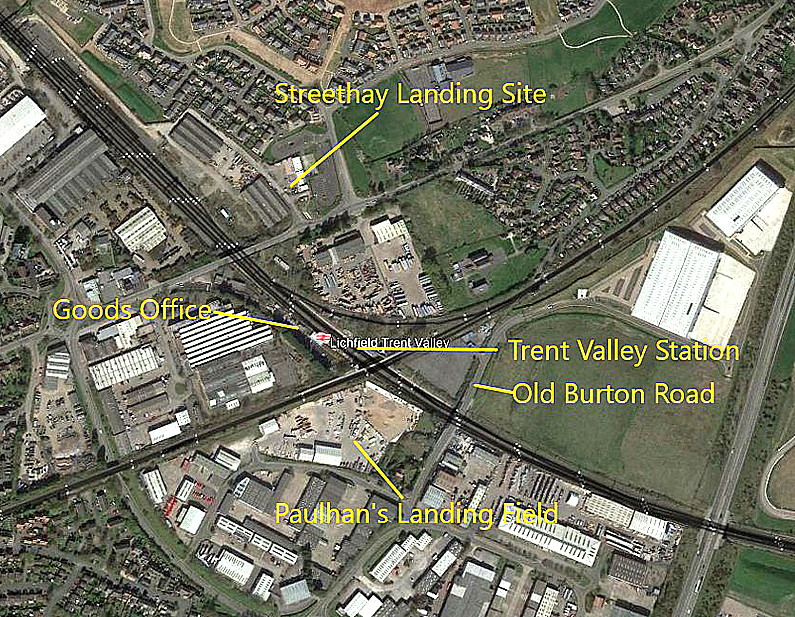Hademore Crossing
HADEMORE CROSSING: Temporary landing site (Aka HADEMORE and HADMORE)
Note: Mike Holder, a great friend of this 'Guide' has kindly provided the illustrations for this listing. Please also read my article, 'The London to Manchester Air Race 1910' which is mostly comprised of pictures, maps and newspaper articles that Mike has unearthed.
Note: This first photo showing the crowds that quickly gathered soon after Claude Grahame-White landed here, was published in The Sketch on the 27th April 1910. The second photo, also from The Sketch, shows the Farnam on its back, having been blown over during the gales that night.
Period of operation: Used on the 23rd April 1910
NOTES: I will quote from C C Turners most excellent book Old Flying Days published in around 1927. He really was incredibly well informed about early aviation history and indeed had been acquainted with most of the famous figures and often a witness to many if not most of the significant events.
For example, regarding Claude Grahame-White’s first attempt at the £1,000 prize which the Daily Mail was offering for the first London to Manchester flight in 1910, he writes: “The crowds at Nuneaton, nearly 100 miles from the starting point, were confident he would win the prize, but when only thirty miles beyond RUGBY, (My note: RUGBY was the first staging point where he landed, see listing for NORMANDY FARM, and LICHFIELD was the second staging post), his engine gave trouble through the breaking of a small screw in the inlet valve of one of the cylinders. A stiff wind was blowing , and Grahame-White accomplished a difficult landing in a field at Hadmore, four miles south of Lichfield.”
Grahame-White was following the direct main-line railway from London to Manchester, (important sections had the track sleepers painted white to help the two competing pilots), . He actually landed near HADEMORE CROSSING, not Hadmore, which is SE of Lichfield. HADEMORE is still also alongside a, (if not the?), main railway line to Manchester in this region.
Note: As Mike points out, the local area map shows the barracks to the south-east, which explains the amount of soldiers in the first picture above.
It is hard if not impossible today to convey what this event meant to the people in those days. There was no TV of course, (or even radio services), but even so tens of thousands turned out to witness the attempt, gathering along the route. The newspapers really were the ‘media’ in those days. It really was the equivalent of the first moon landing! Just getting a glimpse of Grahame-White or Paulhan flying along the route was quite probably the most exciting thing many of these people had experienced in their entire life!
We do not know if the engine was repaired, (Henri Farman and his crew were following along by road), but if so night had set in before Grahame-White could continue. During the night high winds blew the aeroplane over, seriously damaging it. Grahame-White had no option but to abandon this attempt, but, as a mark of the man, he had notified the Daily Mail he’d be making another attempt. And, he did, getting the aircraft repaired in double-quick time, but this time departing from WORMWOOD SCRUBBS instead of PARK ROYAL.
On his second attempt he reached ROADE in NORTHAMPTONSHIRE which was his night stop.
A MICHAEL T HOLDER GALLERY
Later, in July 2022, Mike Holder decided to have a second look at this subject, to see what more might be available? And indeed, he did find some more information which has enabled him to expand upon the items listed above.
The photo with caption was published in the Crewe Guardian on the 20th April 1910. The short article was published in the Northern Daily Telegraph on the 23rd April 1910.
This article was published in the Lichfield Mercury on the 29th April 1910.
This second short article was published in the Buxton Advertiser on the 30th April 1910. The area view is from my Google Earth © derived database.
MORE NOTES: I will happily admit that when first looking at this event, I soon became confused. Nothing seemed to marry up. It was of course the first major long distance air race, so I blithely assumed that both competitors started, as is normally the case, on a given day at a given starting point. Nothing like this actually occurred of course. Looking back, it is now easy to see how such confusion arises - especially in the Lichfield area.
Grahame-White made a considerable head start by a couple of days, coming to grief at Lichfield, the second major staging post. So, having had his aircraft brought back to London to be rebuilt, he set off once again now way behind the Frenchman Paulhan. The fact that he nearly caught him up is remarkable in itself. The stuff of legend fit to be included into books for boys at the time - Spliffing yarns, great adventures, etc.
We'd love to hear from you, so please scroll down to leave a comment!
Leave a comment ...
Copyright (c) UK Airfield Guide





























